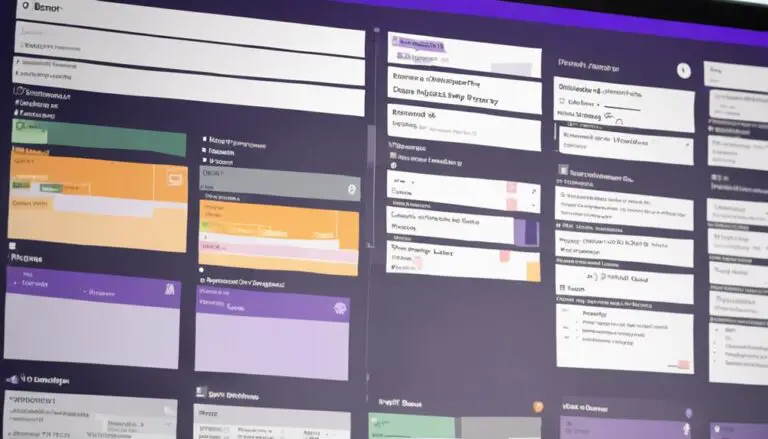Imagine combining the precision of a Swiss watch with the fluidity of a river, creating a harmonious blend that propels your team towards success.
Understanding how to effectively merge Kanban and Scrum methodologies can be a game-changer for your project management strategies. By mastering the art of integrating these two powerful approaches, you can unlock a synergy that maximizes productivity and fosters continuous improvement.
Stay tuned to discover the secrets behind seamlessly uniting Kanban and Scrum to elevate your team's performance to new heights.
Key Takeaways
- Enhance workflow visibility and productivity metrics tracking.
- Achieve predictability, stakeholder engagement, trust, and transparency.
- Optimize collaboration, streamline processes, and track project progress efficiently.
- Ensure cohesive teamwork, adaptability, responsiveness, and enhanced communication.
Overview of Kanban and Scrum
When diving into the realm of project management methodologies, understanding the fundamental principles of Kanban and Scrum is key to optimizing your team's workflow and productivity.
Kanban focuses on visualizing work and limiting work in progress (WIP) to enhance delivery efficiency. On the other hand, Scrum emphasizes iterative development through time-boxed sprints, involving roles like Product Owner and Scrum Master, along with events such as the Daily Scrum.
By combining Kanban and Scrum, you can gain enhanced workflow visibility, increased adaptability, and improved collaboration within your team. Kanban's pull system works hand in hand with Scrum's push approach, ensuring a smoother flow of work items.
This integration of Kanban with Scrum necessitates a deep understanding of both methodologies to effectively manage projects and promote a more cohesive team environment. Embracing these methodologies together can help you achieve a synergistic approach to work that maximizes efficiency and output. By combining the visual management of a kanban board with the iterative approach of Scrum, teams can benefit from improved transparency, increased flexibility, and better workflow visualization. Kanban board benefits include the ability to easily identify bottlenecks, prioritize work, and continuously improve processes. This integrated approach can result in smoother project delivery, better communication, and a more empowered and self-organizing team.
Benefits of Combining Methodologies
To further optimize your team's workflow and productivity, exploring the benefits of combining Kanban and Scrum is essential for streamlining project management practices.
By integrating these methodologies, you can:
- Improve Workflow Visibility: The Kanban Guide for Scrum teams allows you to visualize the workflow, making bottlenecks and blockers more apparent. This enhanced visibility enables your team to react quickly and keep the flow smooth.
- Enhance Productivity with Additional Metrics: The combination provides a broader set of metrics for tracking progress, giving you more insights into how tasks are progressing. This data-driven approach helps in making informed decisions and improving overall efficiency.
- Support Predictability and Stakeholder Engagement: Regular synchronization with stakeholders is facilitated by using both Agile methodologies, ensuring that project delivery timelines are predictable and aligned with stakeholder expectations. This collaborative approach fosters trust and transparency within the team and with external partners.
Key Principles of Kanban
Exploring the foundational principles of Kanban can provide valuable insights into optimizing workflow and enhancing productivity within your team.
The Kanban Method revolves around visualizing workflow, emphasizing the importance of limiting work in progress (WIP) to ensure tasks are completed efficiently. By implementing Kanban practices like managing items, defining workflow stages, and continuously improving flow, teams can deliver value effectively.
In Kanban, participants, known as Kanban system members, collaborate to optimize the flow of value through defined workflows. The central concept of Kanban is finding the right balance in work optimization by visualizing workflow and limiting WIP.
This approach fosters a sense of collective responsibility and teamwork, enabling team members to work together towards achieving shared goals. Embracing the principles of Kanban can lead to smoother workflows, increased productivity, and a stronger sense of cohesion within your team.
Key Elements of Scrum Framework
Delving into the core components of the Scrum framework will illuminate the essential pillars that drive effective teamwork and iterative development. Let's explore the key elements that form the foundation of Scrum:
- Roles: The Scrum framework defines three crucial roles – the Product Owner who represents the stakeholders, the Scrum Master who ensures the team follows Scrum practices, and the Development Team responsible for delivering increments of a product.
- Scrum Artifacts: Within Scrum, three main artifacts are utilized – the Product Backlog containing all product requirements and enhancements, the Sprint Backlog detailing tasks for the current sprint, and the Increment, the sum of all completed Product Backlog items at the end of a sprint.
- Scrum Guide: The official Scrum Guide serves as the definitive resource providing guidelines on the theory, practices, and rules of the Scrum framework, offering a comprehensive understanding of how to implement Scrum effectively.
Understanding these fundamental elements will lay a solid groundwork for embracing the collaborative and iterative nature of the Scrum framework.
Integrating Kanban Into Scrum
Enhancing your Scrum practices with Kanban brings increased workflow visibility and efficiency to your team's development process. By incorporating Kanban boards into your Scrum framework, you can easily visualize work progress and identify any bottlenecks in the workflow. This enhanced workflow visibility allows for better coordination and prioritization of tasks, leading to improved efficiency in delivering value to your customers.
Moreover, by integrating Kanban into Scrum, you gain additional benefits in terms of metrics tracking. Kanban provides valuable insights into cycle times, lead times, and throughput, enabling you to make data-driven decisions and continuously improve your processes. This combination of Scrum and Kanban not only enhances predictability in delivery but also fosters a more collaborative environment where stakeholders are regularly synchronized with the team's progress.
Implementing Scrum Practices in Kanban
Let's explore how you can seamlessly integrate Scrum practices into your Kanban workflow.
By incorporating elements like Sprint Planning, Daily Stand-ups, Reviews, and Retrospectives, you can enhance collaboration and visibility within your team.
Embracing these Agile practices in your Kanban system can help drive continuous improvement and boost productivity.
Scrum in Kanban
Implementing Scrum practices within a Kanban framework enhances collaboration and efficiency by incorporating key ceremonies such as Sprint Planning, Daily Standups, Sprint Reviews, and Retrospectives. This integration allows for a seamless blend of methodologies, optimizing your team's performance.
Here are three ways Scrum events can benefit your Kanban workflow:
- Improved Prioritization: Utilize Sprint Planning to prioritize work items on the Kanban board effectively.
- Enhanced Communication: Daily Standups provide a platform for discussing progress, blockers, and planning tasks collaboratively.
- Iterative Improvement: Conduct Sprint Reviews and Retrospectives to gather empirical evidence, reflect on processes, and make continuous enhancements.
Embrace these practices to elevate your Kanban process and drive better outcomes together!
Agile Integration
Incorporating Scrum practices within a Kanban framework brings together key roles like Product Owner, Scrum Master, and Development Team to foster iterative development and enhance adaptability.
By integrating Agile methodology into Kanban, teams can leverage Scrum events such as Sprint Planning, Daily Scrum, Review, and Retrospective to improve workflow efficiency.
Utilizing Scrum artifacts like the Product Backlog and Sprint Backlog alongside Kanban boards enables clear visualization of work progression.
This synergy of Scrum practices in Kanban optimizes team collaboration and streamlines processes, ultimately enhancing overall productivity.
Embracing the principles of Agile integration allows for a dynamic and responsive approach to project management, ensuring that teams work cohesively towards achieving their goals effectively.
Tools for Managing Kanban and Scrum
When managing Kanban and Scrum workflows, utilizing tools like Jira, Trello, and Asana can greatly enhance task visualization, priority setting, and progress tracking.
Tools for Managing Kanban and Scrum:
- Jira Software: Integrates well with both Kanban and Scrum boards, allowing teams to customize workflows to suit their needs effectively.
- Trello: Its flexible card-based system is ideal for visualizing tasks in Kanban and organizing sprints in Scrum, providing a user-friendly experience for task management.
- Asana: Provides a collaborative platform for managing tasks, timelines, and team communication in a hybrid Kanban and Scrum environment, fostering teamwork and productivity.
These tools offer a range of features that cater to the specific requirements of Kanban and Scrum methodologies, making it easier for teams to stay organized, prioritize effectively, and track progress seamlessly. Embracing these tools can lead to smoother workflows and enhanced collaboration within your Agile team.
Best Practices for Collaboration
Let's focus on teamwork tips and communication strategies that can enhance collaboration between Kanban and Scrum methodologies.
Encouraging joint Sprint Planning sessions and utilizing a shared Kanban board can help align priorities and visualize work effectively.
Implementing cross-functional teams and conducting regular stand-up meetings are key practices to promote collective ownership and address any obstacles that may arise.
Teamwork Tips
To enhance collaboration within your team, prioritize fostering open communication and feedback loops. Creating an environment where team members feel comfortable sharing ideas and providing feedback is essential for building trust and achieving shared goals.
Here are some teamwork tips to boost your team's effectiveness:
- Cultivate Trust: Establish trust among team members by being transparent, reliable, and supportive.
- Embrace Respect: Show respect for each team member's opinions, expertise, and contributions to foster a positive and inclusive environment.
- Promote Shared Goals: Encourage alignment towards common objectives and emphasize the value of working together towards shared success.
Communication Strategies
Enhance your team's collaborative dynamic through effective communication strategies that align with both Kanban and Scrum methodologies. Conduct regular stand-up meetings to discuss progress and blockers, fostering transparency.
Utilize visual tools like Kanban and Scrum boards for enhanced collaboration. Encourage open channels for honest communication to facilitate feedback loops for continuous improvement.
Document tasks, priorities, and decisions clearly for team alignment. Implement feedback mechanisms such as retrospectives and reviews to reflect on communication effectiveness and drive collaboration enhancements.
Continuous Improvement Strategies
Continuous improvement lies at the heart of both Kanban and Scrum methodologies, driving teams to constantly refine their processes for enhanced efficiency and adaptability. When looking to integrate Kanban and Scrum effectively, consider the following strategies:
- Embrace Experimentation: Encourage your team to experiment with new ideas and solutions, relying on empirical evidence to guide decision-making. This approach fosters innovation and continuous growth within your workflow.
- Focus on Workflow Efficiency: Continuously analyze your workflow to identify bottlenecks and areas for improvement. By streamlining processes and eliminating waste, you can enhance productivity and overall team performance.
- Prioritize Adaptation: Be open to change and adapt quickly to evolving requirements and feedback. Embracing a mindset of continuous improvement ensures that your team remains agile and responsive to shifting priorities.
Frequently Asked Questions
How Do I Use Scrum and Kanban Together?
To use Scrum and Kanban together effectively, prioritize tasks collaboratively, fostering team collaboration. Embrace continuous improvement by integrating both methodologies within your agile framework. Ensure seamless workflow by adapting and leveraging their strengths for optimal results.
Can Scrum and Kanban Exist in the Same Project?
Can Scrum and Kanban exist in the same project? Yes, they can coexist through agile integration, employing a hybrid approach for parallel execution. This allows for workflow synchronization, optimizing productivity and adaptability while enhancing team collaboration.
How Do You Establish Flow With Scrum and Kanban?
To establish flow with Scrum and Kanban, focus on creating synergy between the two methodologies. Improve efficiency by prioritizing work, limiting WIP, and visualizing tasks. Enhance collaboration by tracking metrics and streamlining processes for optimal productivity.
What Technique Combines the Methodology of Scrum and Kanban?
To combine Scrum and Kanban effectively, consider Scrumban. It merges the agility of Scrum with the simplicity of Kanban, optimizing processes for agile integration. Enhance team collaboration, optimize productivity, and streamline workflows for better results.
Conclusion
As you reflect on your journey of integrating Kanban and Scrum, remember that collaboration and adaptability are at the heart of this dynamic duo. By embracing the visual clarity of Kanban and the structured iteration of Scrum, you have the power to enhance productivity and respond to change with ease.
Keep striving for continuous improvement and never forget the power of teamwork in achieving your project goals. Embrace the fusion of Kanban and Scrum, and watch your projects thrive like never before.





